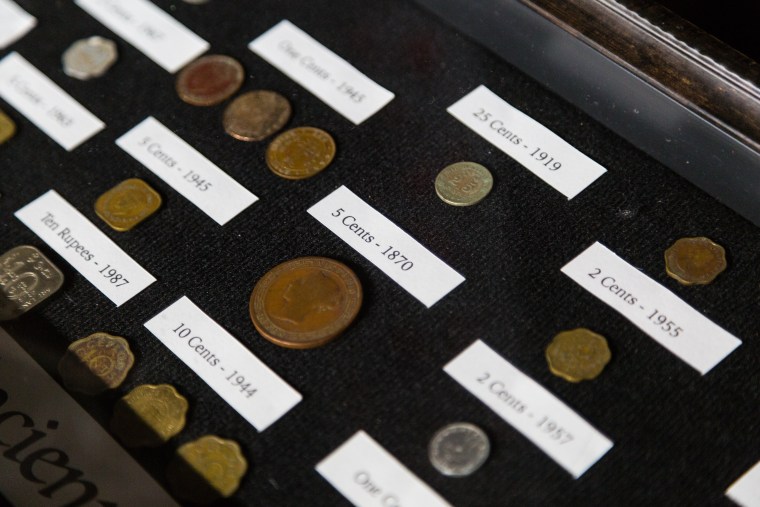Some kids get a smartphone, a laptop, even a car, when they turn 18. Julia Wijesinghe got a 501 (c)(3).
That’s the IRS tax code for nonprofit organizations. It’s also what helped Wijesinghe open the Sri Lankan Art and Cultural Museum in March in the basement of her parents’ restaurant, Lakruwana, in the New York City borough of Staten Island.
“As a kid growing up, it was a struggle to represent who I was,” Wijesinghe told NBC News. “If I meet a new friend, I would say, ‘Oh, I’m from Sri Lanka,’ and they’d have no clue where Sri Lanka is.”
Wijesinghe said she first broached the museum idea to her dad several years back.
“I remember his first impression was literally laughing at me, like, normally that won’t be a typical dream a kid would have,” she recalled.
Her father, Lakruwana Wijesinghe, was supportive. But he told his daughter she first needed to learn the history of the island nation off the coast of India.
“For three years, I started studying,” she said.
"Never be shy of who you are and representing your parents’ country, because you make yourself unique.”
Julia Wijesinghe
Her dad helped by buying her books, some of which had to be translated from the Sinhalese script used there, Julia Wijesinghe said. She also started collecting artifacts to ship to Staten Island on a trip back to Sri Lanka at age 15.
Wijesinghe’s friends, meanwhile, wondered why she cared so much about her parents’ culture, given that she’s a native New Yorker.
But for the college freshman studying computer science, Sri Lanka formed an important part of her identity, she said. She’d been traveling there since the age of 3, spending every summer vacation with her grandmother and visiting historical places.
“That kind of built up my pride,” Wijesinghe said.
The Sri Lankan Art and Cultural Museum occupies a former karaoke room in the basement of Lakruwana, which opened in Staten Island in 2010. It sits on the corner of a three-way intersection in a neighborhood dubbed “Little Sri Lanka.”
Figures from the 2010 U.S. Census show that there were 1,766 Sri Lankans living in Staten Island, though Lakruwana Wijesinghe estimates that the number is closer to several thousand. Like himself, many Sri Lankans followed others who came to this borough, long a refuge for those looking to escape the hustle and bustle of the city.

Over the years, the restaurant has become popular with Brooklyn and Manhattan residents alike, Wijesinghe said, in part because it’s just a short bus ride from the Staten Island Ferry, which connects the borough to Manhattan for free.
Upstairs is a carefully and ornately decorated restaurant — complete with statues of Buddha and wall-hanging painted masks — that serves up a buffet of curries, rice dishes, and other items in clay pots.
After a meal, from Friday to Sunday, diners can descend a set of steep, narrow steps to survey the collection of Sri Lankan artifacts Julia Wijesinghe has amassed with help from her dad, who paid for them.
“I have only one daughter,” Lakruwana Wijesinghe said.
An only child himself, he recalled how his own parents helped him when he came to the U.S. in the early 1980s, first opening a Sri Lankan restaurant in Manhattan in the following decade.
“I had to do the same thing for my daughter,” Wijesinghe said.
The museum aims to display Sri Lanka’s range of art, culture, and history, from ancient to present day, according to Julia Wijesinghe.
Sculptures of Buddhist and Hindu deities share space with bark from a rubber plant and famous Ceylon tea. (Ceylon was Sri Lanka’s name as a former British colony.) Currency, coinage, musical instruments, and clay pottery are among the artifacts that round out the eclectic collection.
On an early October weekend when NBC News visited, Julia Wijesinghe led three women who had just finished dining upstairs on a tour.

A chisel in hand, she demonstrated on real bark how Sri Lankans traditionally tapped a rubber tree for its sap. Brought over from South America, rubber trees were planted on the island in the late 19th century during British colonial rule, according to the Planters’ Association of Ceylon.
Julia Wijesinghe’s breadth of knowledge impressed Dana Roth, in from Boston, who said she knew nothing about Sri Lanka before visiting.
“As a kid growing up, it was a struggle to represent who I was. If I meet a new friend, I would say, ‘Oh, I’m from Sri Lanka,’ and they’d have no clue where Sri Lanka is.”
Julia Wijesinghe
“I was, like, blown away,” Roth said.
The museum collects a $5 donation, which goes toward a charitable foundation Julia Wijesinghe’s father started in the mid-2000s. The money helps buy books, food, and uniforms for children at a school in Sri Lanka, Julia Wijesinghe said.
Just seven months after opening the museum, Julia Wijesinghe said they're planning on moving it to a larger space they’re renting a few blocks away. It should make its debut sometime early next year, she added.
While some children and young adults of immigrants shed their ancestral roots, others plant them even further. Wijesinghe, who turns 19 in late November, hopes her museum can inspire other young people to do the same.
“Never be shy of who you are and representing your parents’ country, because you make yourself unique,” she said.
Follow NBC Asian America on Facebook, Twitter, Instagram and Tumblr.